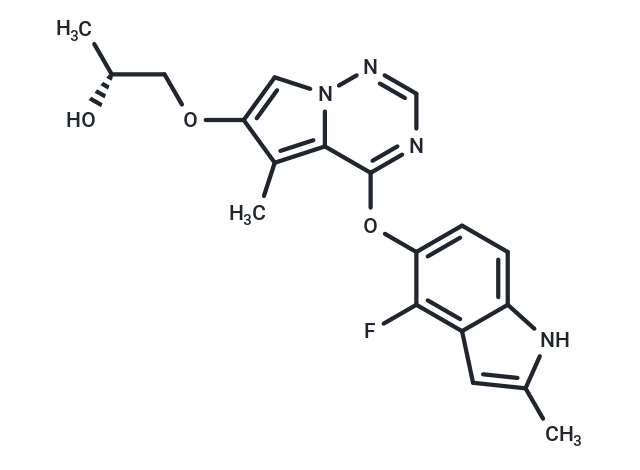Shopping Cart
- Remove All
 Your shopping cart is currently empty
Your shopping cart is currently empty

Brivanib (BMS-540215) is an ATP-competitive inhibitor targeting VEGFR2 with an IC50 of 25 nM, exhibiting moderate potency against VEGFR-1 and FGFR-1, and over 240-fold selectivity against PDGFR-β. Phase 3.

| Pack Size | Price | Availability | Quantity |
|---|---|---|---|
| 1 mg | $39 | In Stock | |
| 5 mg | $90 | In Stock | |
| 10 mg | $147 | In Stock | |
| 25 mg | $273 | In Stock | |
| 50 mg | $395 | In Stock | |
| 100 mg | $589 | In Stock | |
| 200 mg | $857 | In Stock | |
| 1 mL x 10 mM (in DMSO) | $98 | In Stock |
| Description | Brivanib (BMS-540215) is an ATP-competitive inhibitor targeting VEGFR2 with an IC50 of 25 nM, exhibiting moderate potency against VEGFR-1 and FGFR-1, and over 240-fold selectivity against PDGFR-β. Phase 3. |
| Targets&IC50 | VEGFR2:25 nM |
| In vitro | Brivanib also inhibits VEGFR1 and FGFR-1 with IC50 of 0.38 μM and 0.148 μM. Brivanib is not sensitive to PDGFRβ, EGFR, LCK, PKCα or JAK-3 with IC50 all above 1900 nM. Brivanib could inhibit the proliferation of VEGF-stimulated HUVECs with IC50 of 40 nM, compared to 276 nM in FGF-stimulated HUVECs. On the other hand, Brivanib exhibits low activity to tumor cell lines. [1] |
| In vivo | Brivanib exhibits antitumor activity in H3396 xenografts in athymic mice, completely inhibiting tumor growth at 60 and 90 mg/kg (p.o.) with TGIs of 85% and 97%, respectively [1]. It also significantly suppresses tumor growth in Hepatocellular carcinoma (HCC) xenografts by decreasing VEGFR2 phosphorylation, resulting in tumor weights of 55% and 13% compared to controls at doses of 50 mg/kg and 100 mg/kg. Brivanib shows potential for efficient treatment of HCC [2]. |
| Kinase Assay | In Vitro Kinase Assays: Recombinant proteins containing tyrosine kinases are expressed as GST fusion proteins using baculovirus expression vector system in Sf9 cells. All enzymes are stored at -80 °C. Brivanib is dissolved in DMSO and diluted by water/10% DMSO. The VEGFR2 kinase solution is composed by 8 ng GST-VEGFR2 enzyme, 75 μg/mL substrate, 1 μM ATP, and 0.04 μCi [γ-33P]-ATP in 50 μL buffer: 20 mM Tris (pH 7.0), 25 μg/mL BSA, 1.5 mM MnCl2, 0.5 mM dithiothreitol). Flk-1 kinase solution is composed by 10 ng GST-Flk-1 enzyme, 75 μg/mL substrate, 1 μM ATP, and 0.04 μCi [γ-33P]-ATP in 50 μL buffer: 20 mM Tris, pH 7.0, 25 μg/mL BSA, 4 mM MnCl2, 0.5 mM dithiothreitol). The reactions are incubated for 1 hour at 27 °C and terminated with cold trichloroacetic acid (TCA) to a final concentration of 15%. These TCA precipitates are collected onto unifilter plates and quantitated by liquid scintillation counter. |
| Cell Research | The cells are stimulated by VEGF or FGF at a concentration of 8 or 80 ng/mL. These cells are seeded in 96 well plates at a density of 2 × 103 and incubated for 24 hours. Brivanib at various dilutions are added to the cells for another 48 hours. Then 0.5 μCi of [3H] thymidine is added for 24 hours. After that the incorporated tritium is quantified using a β-counter. (Only for Reference) |
| Alias | BMS-540215 |
| Molecular Weight | 370.38 |
| Formula | C19H19FN4O3 |
| Cas No. | 649735-46-6 |
| Smiles | C[C@@H](O)COc1cn2ncnc(Oc3ccc4[nH]c(C)cc4c3F)c2c1C |
| Relative Density. | 1.42 g/cm3 |
| Storage | Powder: -20°C for 3 years | In solvent: -80°C for 1 year | Shipping with blue ice. | ||||||||||||||||||||||||||||||||||||||||
| Solubility Information | Ethanol: 3 mg/mL (8.1 mM), Sonication is recommended. DMSO: 69 mg/mL (186.3 mM), Sonication is recommended. H2O: <1 mg/mL | ||||||||||||||||||||||||||||||||||||||||
Solution Preparation Table | |||||||||||||||||||||||||||||||||||||||||
Ethanol/DMSO
DMSO
| |||||||||||||||||||||||||||||||||||||||||

Copyright © 2015-2025 TargetMol Chemicals Inc. All Rights Reserved.